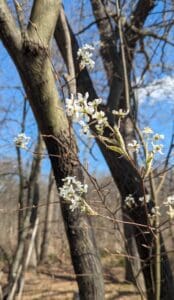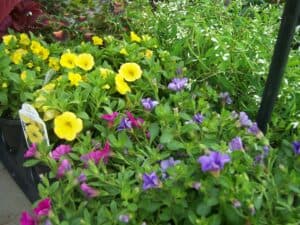
Article and photos by Master Naturalist Doug Jackson
Driving around these parts of Michigan right now, you’ll notice some trees bursting with white blossoms before any of the other trees bloom.
In our cities and villages, you’re most likely seeing the Bradford pear trees along the roadsides.
The beauty of these ornamental trees’ blossoms is about the only benefit they have to offer.
Bradford pears are non-native and incredibly invasive. They do not benefit wildlife in any way and can rapidly spread to neighboring wild areas, displacing the beneficial native flora in those fields and woods. In fact, even their fruit is inedible to humans.
The other white-blossomed trees we see now—mostly in wooded or natural areas—are the serviceberry trees, or shrubs, in the genus Amelanchier and in the rose family.
Their fragrant blossoms are delicate, five-thinly-petalled, and about the diameter of a nickel.

The bark of these small trees is light gray and smooth with sinewy vertical lines.
The winter buds are red, long, thin, and lance-like.
Unlike the Bradford pear, Amelanchier are native, beneficial to wildlife, and their fruit are edible—some of which can be very tasty.
The serviceberry can be a source of confusion and debate among naturalists.
There are six native varieties and several cultivars of Amelanchier in Michigan. The two most common species I’ve seen around here are the downy serviceberry, A. interior, and the smooth serviceberry, A. laevis.
Among all these species, these plants can hybridize with one another, thus making positive I.D. of some of these species a bit of a challenge.
These plants can grow as a shrub like the shadbush serviceberry, A. spicata, or a small, skinny tree like the downy or smooth serviceberry.
Amelanchier bloom in early April and their small, dark, blueberry-like fruit ripen in June.

Just from my own experience, the downy variety seems to have a rather woody, tasteless berry, while the smooth variety has been described as sweet as a blueberry and favored for pies and other delicacies.
Other sources of confusion with Amelanchier are their common names.
“Serviceberry” is perhaps the most used name and comes from the days before power earth-digging equipment. When these plants bloomed, that was the signal that the ground was thawed and soft enough to bury those who died over the winter.
“Shadberry” is another name used and came from the same era. People would know it was time for the shad fish to swim upstream to spawn when these trees went to bloom.
“Juneberry” is yet another common name for these plants, stemming from the fact that their berries ripen in June.
“A rose by any other name would smell as sweet.” Perhaps Shakespeare hit the nail on the head with this rose family member.

If you’re lucky enough to have a smooth serviceberry or shadbush near you, be quick and diligent about harvesting those berries. People are not the only creatures that love them.
Birds favor these berries in June because of their high sugar content, offering them the instant energy they are seeking after a long migration and nesting period.
But, if you’re more like me, you’ll most likely find some leftover berries that wind up tasting like twigs anyway.
And if you’re looking for a beautiful landscaping tree or bush, walk right past those Bradford pears and pick out a native serviceberry. It will keep you and your neighborhood wildlife smiling well past the blossoms falling off.



















